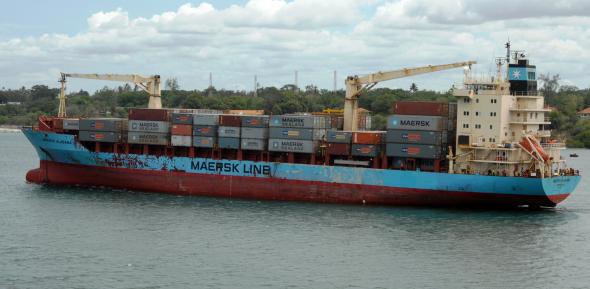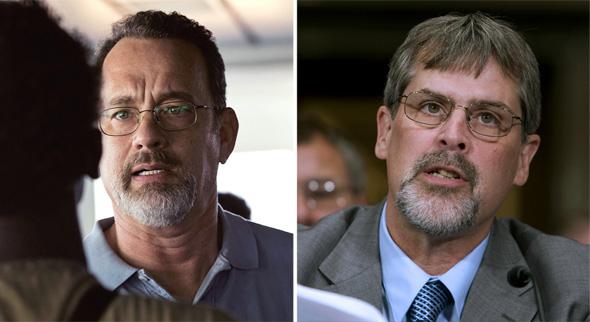Speaking about the accuracy of his new movie Captain Phillips, Tom Hanks has said, “If you read the book, a lot of stuff has been omitted. But thematically, I don’t think a thing has.” “By and large,” he added, “everything we’ve done in the film is empirically accurate, if that makes sense.” Is he right?
Sure, by and large. Captain Phillips condenses the story of the Maersk Alabama hijacking, omitting a few details, changing a few others, and, in Paul Greengrass’ signature style, zooming in on the key events in a short period of time, even if that means neglecting some of the larger context. Some of the movie’s most seemingly unbelievable details are pulled straight from A Captain’s Duty, Richard Phillips’ book-length account of the Alabama saga.
Of course, there’s also the accuracy of Phillips’ account to consider. Many of Phillips’ crewmembers, some of whom are in the midst of a lawsuit they filed against the ship’s owners, claim his account misrepresents the story. According to them, Phillips behaved irresponsibly: They say he ignored warnings about pirates in the area and sailed too close to the Somali coast. One of Phillips’ crew, a man who goes by the name ATM, has also claimed that he alerted Phillips to the pirates only to have Phillips dismiss him: “I told him, ‘Captain, I’m damn sure this is pirate boat,’” ATM has said. “He laughed at me. He told me it could be a fishing boat. He walked away from me.” Phillips denies this. In a new documentary, Abduwali Abdukhadir Muse, the head hijacker played in the movie by Barkhad Abdi, also claims that his story hasn’t been told.
Having not yet seen the documentary, my primary source for what follows is Phillips’ own account, plus news reports where available.
Before the hijacking

Photo by Laura A. Moore, U.S. Navy.
As in the movie, Phillips received bulletins about recent hijackings in the surrounding waters but chose to keep his course. The Alabama sailed 300 to 400 miles from the Somali coast, in order to maintain a faster, more direct route, even though at least one warning cautioned that “vessels should consider maintaining a distance of more than 600 miles from Somalia coastline.” Most of the warnings were directed at all the ships in the area, but one was sent directly to Phillips. Unlike in the movie, Phillips didn’t hide the surrounding hijackings from his wife, Andrea, according to the book.
The hijackers’ first attack
The hijackers’ first, failed attack plays out in Phillips’ account much as it does in Greengrass’ film. But the Alabama wasn’t in the middle of a pirate drill when they were attacked—they were in the middle of a “fire and boat drill.”
Once they realized they were being pursued, Phillips says he radioed the United Kingdom Marine Trade Operations (UKMTO) about a “potential piracy situation.” The UKMTO, according to Phillips, said, “It’s probably just fishermen” and asked them to prepare. The U.S. emergency line didn’t pick up.
The detail about Phillips faking a radio communication with the U.S. military in order to scare off the pirates is also, remarkably, true to Phillips’ account. According to the book, he pretended to radio as “Warship 237”—to play the second voice, he lowered his voice and dropped his Boston accent—in order to suggest that a helicopter was on the way. The boats eventually turned away.
Taking the ship

Left: Photo still courtesy Columbia Pictures/Sony Pictures Releasing. Right: Photo by Rick Maiman/Bloomberg via Getty Images
As in the movie, the hijackers were successful on their second attempt. Despite the Alabama’s efforts to repel the pirates using fire hoses, “racing maneuvers” (swaying back and forth), and flares (fired by Phillips), the pirates eventually threw up a ladder and boarded the ship, taking the bridge.
Much of the dialogue that follows in the film is taken almost verbatim from Phillips’ book. The pirates, in Phillips’ account, said, “Relax, Captain, relax,” “No Al Qaeda, no Al Qaeda,” and explained that it was “Business, just business.”
Business or not, Phillips tried to slow their progress any way he could. He pretended he didn’t understand them, that the ship was “broken,” and he surreptitiously turned on his radio to sneak news to his crew. They really did offer the pirates the $30,000 from Phillips’ safe, but the hijackers wanted much more.
Taking Muse hostage, and negotiating
The crew’s efforts to take the ship back are also largely accurate, though some details seem to be invented. The book, for example, never describes a barefoot pirate stumbling on a field of broken glass, left by the crew as a booby trap. (According to the book, they all had sandals.)
As in the movie, it was chief engineer Mike Perry that scuffled with Muse in the dark of the engine room and, after badly cutting Muse’s hand, used the knife to take him hostage. This shifted the balance of power, and the crew was eventually able to negotiate an exchange of Muse for Phillips. But after Phillips went down to the lifeboat to help the pirates get it started, the hijackers kept Phillips and reneged on the deal.
Though he was made a hero by ensuing media reports, Phillips doesn’t call himself a hero for these actions. In the movie, Phillips says things like, “If you want to shoot someone, shoot me!” But Phillips says that he never meant to sacrifice himself for the crew.
Life on the rescue boat

Photo by the U.S. Navy
In real life, Phillips was on the rescue boat for almost five days, whereas in the movie it seems—as Dana Stevens and David Weigel put it in a recent Slate Spoiler Special—more like 36 hours or so.
Over those five days, the extreme heat raised tensions, and the pirates broke the boat’s windows to let in some air. (Phillips says he really did have to suggest that they remove their clips before using a gun to break the window.) Phillips also describes how the pirates “claimed they were former fishermen who’d been forced into banditry when their livelihoods disappeared,” just as they do in the movie. But the real hijackers might not have been quite so isolated: According to the Associated Press, officials said they were communicating with other pirate boats via satellite phone.
As in the movie, things got much worse after Phillips tried to escape, while one of the pirates was urinating off the boat. (Though Phillips says he just darted past him, rather than pretending to go to the bathroom himself.) After that, Phillips says the pirates beat him, started playing mind games with him (he was becoming paranoid), and performed mock executions. They asked him if he wanted beer, thinking that all Americans loved beer.
The final confrontation
After preliminary negotiations, during which the Navy sent many chocolate Pop Tarts, Muse boarded the Bainbridge “to discuss ransom and conditions with the navy,” and the remaining hijackers soon agreed to let the Americans tow the lifeboat. They also sent Phillips a bright yellow shirt to wear, so they could tell him apart. As in the movie, things became even more chaotic without Muse on the lifeboat, though Phillips doesn’t mention anything about writing a note to his family. (He does mention praying for them.)
As soon as the Navy SEAL snipers—members of SEAL Team Six, the same team that took out Osama bin Laden—were able to get clean shots on all three pirates at once, they killed them almost simultaneously, with one shot each to the head.
Aftermath
Abduwali Abdukhadir Muse was sentenced as an adult to 33 years in prison, as Captain Phillips says, though his age was a controversial issue in the trial. According to a prosecutor, “he gave wildly varying ages for himself but finally admitted he was 18.” Since his arrest, he has tried to commit suicide multiple times, according to his attorneys. The director of the documentary about Muse says that the Somalian declined Sony Pictures’ many attempts to meet him, having decided that they “were just going to make him a bad guy.”
The last scene of the movie, of Phillips in shock, was improvised, according to Hanks. Phillips doesn’t describe in much detail what happened immediately after he was brought on the ship, besides being checked out by the doctor, waking up sobbing in the middle of the night, and talking to President Obama about the hijacking. He does mention that, when he was first asked if he needed anything, he said, “I’d love a beer.”
